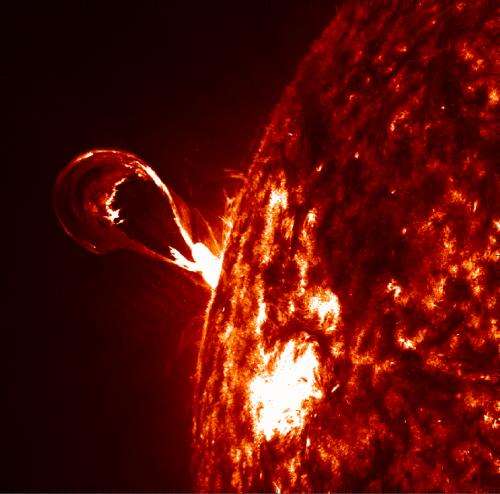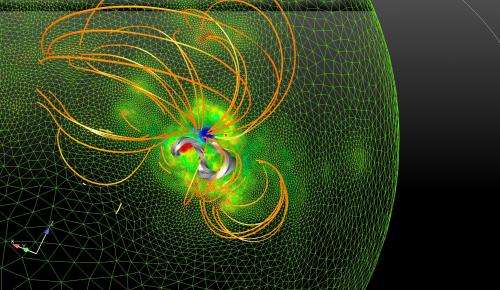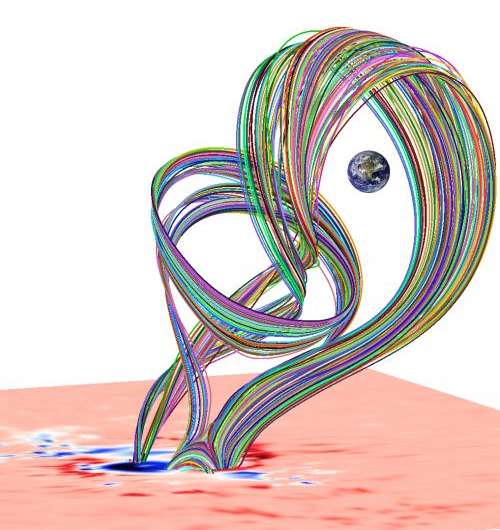SOHO and Hinode offer new insight into solar eruptions

The sun is home to the largest explosions in the solar system. For example, it regularly produces huge eruptions known as coronal mass ejections – when billions of tons of solar material erupt off the sun, spewing into space and racing toward the very edges of the solar system. Scientists know that these ejections, called CMEs, are caused by magnetic energy building up on the sun, which suddenly releases. But the details of what causes the build up and triggers the release are not precisely understood.
A journal paper in Nature magazine on Oct. 23, 2014, used data from NASA missions to present an example of how something called a magnetic flux rope builds up over time until it is so unstable that even the slightest perturbation will send it flying. Understanding what triggers CMEs is crucial not only for better understanding of our sun, but also to lay the groundwork for predicting when such giant explosions might happen.
"We looked at a well-studied CME from 2006," said Tahar Amari first author on the Nature paper at Ecole Polytechnique in France. "We knew that there had been a great deal of data available for this CME and much analysis already done, but no one had created a comprehensive picture of what happened."
Amari and his colleagues used a traditional meteorology technique to examine the event: Gather observations from the days before the CME to track how the event grew over time. They used observations from the European Space Agency and NASA's Solar and Heliospheric Observatory, or SOHO, and the Japanese Aerospace Exploration Agency and NASA's Hinode, as well as from the Paris-Meudon Observatory.
The team wanted to see if they could distinguish between two broad theories about how the magnetic energy develops. The first model describes a situation in which a series of loops of magnetic fields on the sun – known as an arcade – is the start of every active region CME. This arcade has a weak point at the top, a place where the energy from below can burst through once it's great enough. During the eruption a flux rope forms, which can be seen inside the CME as it surges away from the sun.

The second model assumes that the flux rope is there before the CME erupts. In this theory, no weak point is required. Instead, the flux rope gains more and more energy, and becomes increasingly unstable until a disturbance on the sun causes it to release the energy out into space.
Amari and his team used magnetic data from the surface obtained by Hinode, but they also needed magnetic data for the sun's atmosphere, the corona, which is strongly affected by its magnetic field.
"The corona is so hot that most of the techniques to measure the magnetic field don't work," said Amari. "So we developed an efficient and accurate model to compute the magnetic field there, based on the data we had from the surface, and the equations governing the physics of the low corona above active regions."
With these two data sets in hand, the team examined what happened in the four days before the 2006 CME erupted. They could see the magnetic energy building; it was clear something was emerging. Only, however, on the last day did a flux rope develop and only then did it have enough energy built up to power a CME eruption. At this point, some small disruption was enough of a nudge to make the flux rope erupt.

"In this case no weak point up in the atmosphere was needed to allow the energy to be released," said Amari. "There is, instead, a kind of critical value of energy, a value we can compute based on seeing an active magnetic region on the sun. Beneath that value the magnetic field will stay quiet. Above that, it is likely to erupt. There is also a critical height for rising flux rope, beyond which the magnetic loops above can no longer keep it confined."
The team explored the initial conditions from this event and put the information into another dynamical model the team had developed. The simulation mirrored what was actually seen, with an eruption occurring only when the critical energy and height were reached on the last day.
Amari points out that just because this CME contained a flux rope prior to eruption, it doesn't mean that other CMEs can't erupt based on other physical catalysts. But it clearly describes one mechanism that is at work on the sun.
By measuring and calculating the magnetic fields on the sun, coupled with determining how to measure the critical tipping point where a CME can erupt, the paper offers new ways to determine the possibility of eruption from any given active area on the sun.
More information:
For more information about the European Space Agency and NASA's SOHO Mission, visit:
www.nasa.gov/soho/. For more information about the Japanese Aerospace Exploration Agency and NASA's Hinode, visit: www.nasa.gov/hinode
Journal information: Nature
Provided by NASA





















